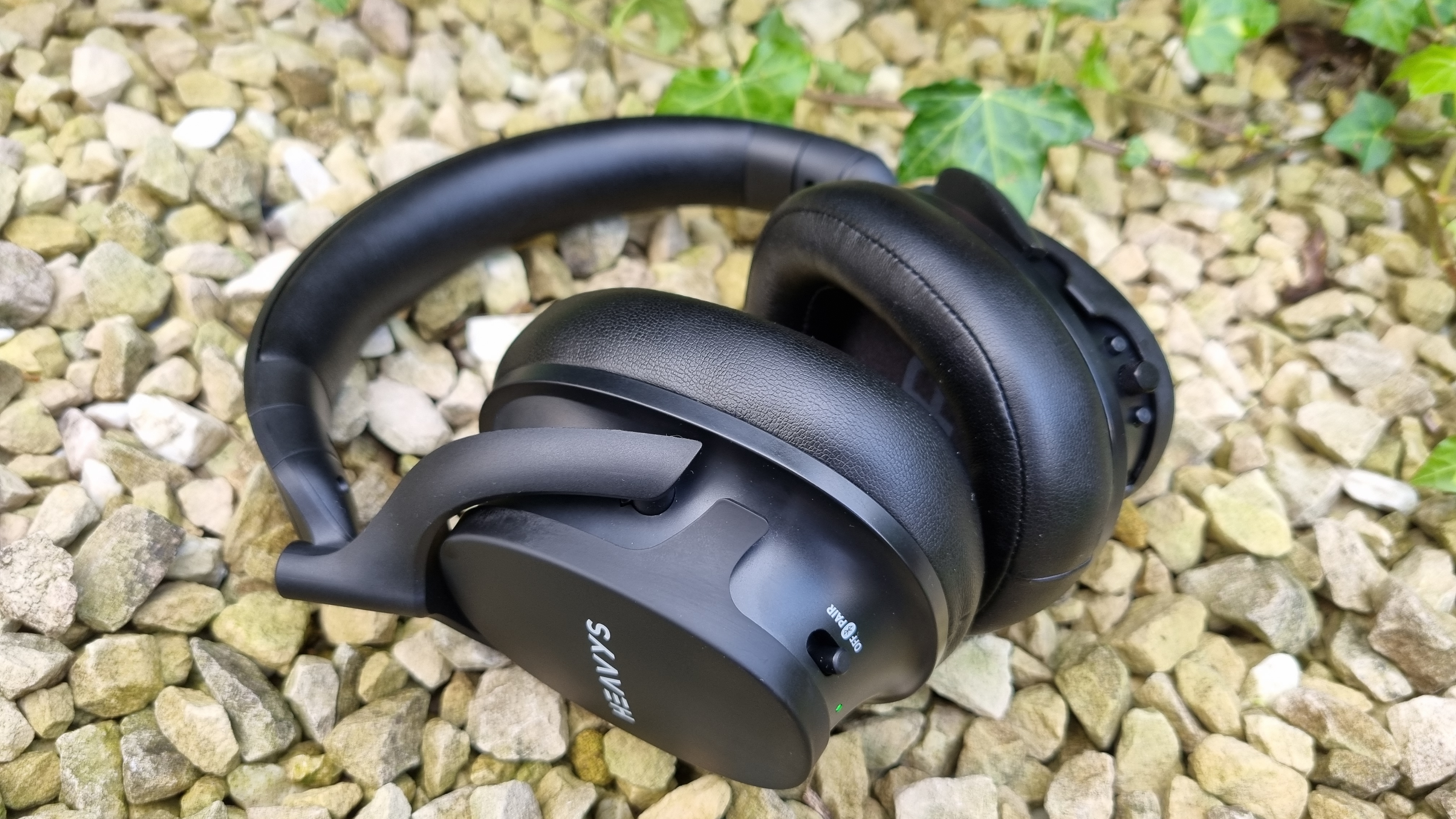
Heavy metal, man.
I like to think I’m immune to targeted advertising, or at the very least resistant. But at some point we all fall victim to the algorithm, and so the whirring cogs behind my Google Discover feed correctly identified that not only am I obsessed with audio, but also a long-haired human being with a taste for heavy metal music (among many other genres, of course).
And thus, I was shown an advert for the Heavy H1H wireless headphones, somewhat aggressively marketed as the “world’s first headphones built for metal fans mimicking the live music experience.” Initially I scoffed at the concept, but on closer inspection I’ve come to realise there’s actually some really interesting headphone design going on here.
For a start, they’ve been designed by Axel Grell, chief engineer at Sennheiser. That’s a man who has learned a thing or two about audio in his 30 years in the industry. More than that though, these headphones make use of eight individual drivers, feature “Hell Blocker” active noise cancellation (you may start rolling your eyes here), Bluetooth 5.1, five beamforming microphones, and a 50 hour battery life—all for $269/£245. Pricey then, but not too bad for audiophile-specced premium noise cancellers.
Ah, go on then. I had to satisfy my curiosity, at the very least. My review units came in an all-black box that looks more suited to high-end aftershave than a set of cans, with h-e-a-v-y-s printed in a stark white font. Everything other than the logo is black, black as my heart, and that includes the headphones themselves. These are substantial units, although they’re capable of folding up into a more compact size to squeeze themselves into an included hard-shell carry case.
(Image credit: Future)
Style: Over-ear, closed-back
Drivers: Eight total, 4x 38 mm dynamic drivers, 4x high-frequency tweeters
Frequency response: 5 Hz to 46,000 Hz (wired), 5 Hz to 24,000 Hz (Bluetooth)
Microphone: Five mic array
Battery life: Up to 50 hours
Connection: Bluetooth 5.1, 2.5 mm to 3.5 mm wired connection (with included cable)
Weight: 410 g
Price: $269/£245
They’re also quite weighty, although 80 g lighter than our favourite audiophile wireless headset, the Audeze Maxwell. I’m not averse to a chonky set of phones, however, and these are super-comfy, at least. That’s thanks to some plush leatherette cushions and a squidgey-soft internal headband lining.
The rest of the build is a mix of tough ABS plastics with a premium-feeling satin finish. They really do look and feel like the cat’s pyjamas, although that satin coating is a bit of a fingerprint magnet—which spoils the look somewhat as you pose about with your new cans.
Speaking of posing (and despite the stealth black aesthetic), these headphones really will make you stand out. That clamshell folding mechanism is very convenient for shrinking them down for travel, but it means that when they’re unfolded and atop your head, the Heavys look wide with a capital “woah”.
You can just about fit them inside a raised hoodie when it’s raining, but be prepared for everyone to notice you’re wearing some serious-sized earwear.
(Image credit: Future)
(Image credit: Future)
(Image credit: Future)
Control-wise, you’ve got a switch for Bluetooth mode and pairing on the left earcup, and a proper miniature volume dial on the right, with push-to-click muting and weeny little skip buttons sitting on either side. Next to that is a three-way switch for power on, off, and noise cancelling.
Sorry, that should be on, off, and 🤘Hell Blocker🤘. I forgot where I was for a moment.
The good news is, this switchgear all feels great, with properly chunky actions. The bad news is, you’d better get used to using that power switch, as there’s no auto shut-off here. Unless my review units are broken of course, but it’s led to more than a few instances where I’ve come home from work, sat the Heavys down on my desk, and found them still blinking away the next morning.
(Image credit: Future)
I could also do without the over-the-top voice clips accompanying actions like reaching maximum volume or activating noise cancellation. It sounds like someone impersonating Satan on his day off—presumably to match the heavy metal theme—but it’s more than a little cringe-inducing.
“MAXIMUM VOLUME,” growls the voice artist in his best Duke Nukem. “Please stop embarrassing me on the train,” I hiss in response.
Anyway, let’s talk about that weird driver setup. First clues here are found inside the earcups—the tweeter units are positioned separately, in the front half of the cup, standing proud from the inner cushioning and pointing across your ears, not directly at them. As for the regular drivers? Rather than one main unit per earcup, here you get two 38 mm units stacked on top of one another each side.
This creates a remarkable amount of definition in the sound. With the tweeters sitting a noticeable distance away from the main drivers and pointing across your ear holes, you get shiny, silky treble and thundering bass at the same time with little crossover, allowing both to exist prominently in the mix without descending into mush.
(Image credit: Future)
I know, all very flowery language that, isn’t it? But as someone who has used more high-end headphones than you can count, I was very impressed on my initial test listen—in which I went through my test playlist of well-mixed, genre-ranging tunes, keeping an ear out for flaws. Standard headphone testing really, but those excellent drivers perform with aplomb.
However, that’s not the primary purpose of these beasts. These are headphones built for heavy music, and so it’s time to break out the good stuff. Challenge accepted.
Kicking things off with Mork’s black metal stunner, “På Tvers Av Tidene”, it’s easy to hear that ice-pick definition in action. What’s really impressive is the level of kick these headphones are capable of creating without missing out on the details, so weighty toms are allowed to thump independently from the bassline, while cutting guitars grind through the sonic soup appropriately.
Turning things old school for a second, Metallica’s “Sad But True” has all the appropriate weight you’d expect from those multi-layered guitars, with Lars’ snare drum snapping distinctly down the middle of the mix. Deep Purple’s live recording of “Black Night” from the seminal “Made in Japan” (yes I grew up on my Dad’s record collection, what of it?) shows off an impressive amount of space in the staging and is probably the best I’ve heard it on any set of phones under $300.
(Image credit: Future)
It’s not just metal that benefits from this multi-driver setup, either. Hip hop? Those main drivers love a kick drum, with some meaningful sub-bass skull-rattling to boot. Bluegrass-influenced folk? There’s delicacy in those tweeters, and that lets banjos and fiddle parts shine.
So, musically, these are pretty fantastic for a wireless set of cans, and have quickly become my go-to for high-quality audio on the move. But what about gaming?
…they are superb, multi-talented, and rather gorgeous headphones.
Well, as you may have seen from the spec sheet, these are Bluetooth only for wireless. No regular RF connection here, nor a latency-free 2.4 GHz dongle. And while this is a relatively modern version of the Bluetooth wireless protocol (5.1, which I tested with my own Bluetooth 5.3 adapter on PC), that still means audio delay.
How much this matters to you will depend on your tolerance for less-than-perfect latency, and the type of gaming you enjoy. For strategy, RPGs, and anything more slower-paced than the mean, I’d say it’s actually fairly usable by Bluetooth standards—although the delay is definitely there.
Really though, it’s best to treat these headphones as wireless for travel, and wired units for sitting at your desk.
(Image credit: Future)
A 2.5 mm to 3.5 mm jack cable is included, but at 1.3 metres it’s slightly too short. My setup is positioned right next to me on my desk, so it’s just about suitable, but a longer cable would be much appreciated. The 2.5 mm port lives deep inside a recess on the right earcup, meaning that if you do buy a longer version, it’ll need to have a very skinny connector size to fit. A standard 3.5 mm jack on the outside would be a much better design choice.
Several beamforming mics are built into the unit for Bluetooth, but for a wired connection, you’ll need the slightly more expensive gaming bundle with an included in-line boom mic to make yourself heard.
That particular cable didn’t make it to me in time for review, but it’s where I’d be aiming to turn the Heavys into a gaming headset extraordinaire. It’s a shame it’s not included in this package, but there you go.
What I can say is that, wired, the Heavys do just as good a job at delivering gaming audio as they do music. Explosions have genuine punch, soundtracks soar, and that multi-driver design shows its usefulness once again when turned towards the atmospheric.
(Image credit: Future)
Ghost Recon Breakpoint has excellent audio design, with chirping wildlife, crunchy snow and claustrophobic forests, and the wide and distinctly spacious soundstage of the Heavys allows all of it to breathe with the correct sense of scope and space.
These cans are proof that, in actuality, a really good set of drivers is the most important thing for gaming audio, and a great set of headphones will absolutely deliver quality sound for gaming in the same way they do music. It’s the sound staging that really matters in a good gaming headset, and these cans perform admirably.
✅ You want properly punchy, detailed audio: The Heavys H1H headphones are built to entertain, and the sound they deliver is both fun and beautifully detailed at the same time.
✅ You don’t mind plugging in for gaming: While the Bluetooth connection here is usable, you’ll really want to plug these in to eliminate any lag.
❌ You want a boom mic as standard: It’s available separately (or as part of a different bundle), but the built-in mics will only work via the Bluetooth connection, and that’s where the latency lies.
❌ You’re prepared to pay for the Audeze Maxwell: As good as the Heavys are, the Maxwell gives you a proper mic and a lag-free wireless connection as standard.
All this makes the Heavys something of a difficult product to weigh up. On the one hand, they’re superbly well-made, properly punchy, nicely detailed, and a pleasure for wireless day-to-day fun. On the other, for gaming, you really need to plug them in. And an extra cable on top of the price for a wired boom mic? A definite misstep.
But truth be told, I’m very fussy about sound, and I’ve been using them non-stop as music machines over the past few months—with some plugged-in gaming hijinks at the weekend.
They really are very good at what they do, and sometimes you like a piece of kit so much, you’ll forgive its flaws—simply because, if you’d paid your own money, you’d be genuinely pleased with it.
And that’s the case here. The Heavys H1H headphones don’t make for a perfect gaming headset experience, but they are superb, multi-talented, and rather gorgeous headphones. They’ve been making me bang my head with approval since I pulled them from the box, and that’s worth a lot if you ask me.
I’d still pay the extra for the planar magnetic Audeze Maxwell over the Heavys if pushed, mainly for the proper wireless connection and included mic. Plus, planar magnetics are always going to beat out traditional drivers when implemented properly, even fantastic-yet-oddball ones like these. But all that being said? The Heavys H1H headphones are still my sort of jam, man.





